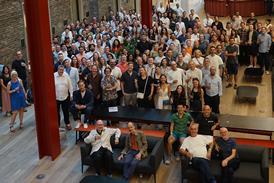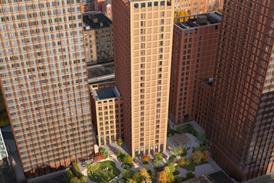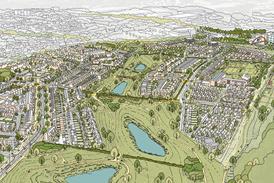ARB’s proposed education reforms offer the perfect opportunity to reimagine the profession, writes Charles Bettes

The traditional three-part route to qualifying as an architect in the UK is outdated and exclusive. It doesn’t cater for those who can’t afford it or who learn in different ways; it hasn’t done enough to encourage individuals from diverse backgrounds and nor does it do enough to retain them.
During my education I felt that much of the course was focused on creating the ‘master architect’, which doesn’t relate to the real job done by most architects and is an outdated vision of what the architect should and could be. It also wasn’t what I wanted to be, which meant that I finished my Part 1 unsure about a career in the industry.
This master architect stereotype and training limits our areas of influence within the built environment and how we can communicate and relate to the rest of the team involved with creating buildings, as well as those who use them. For me, my interest in architecture started when I began working after my Part 1 and got experience on real projects in the city.
The skills I was able to learn and use whilst working felt far more real than what I felt was an overly conceptual environment at university. I was problem solving, building confidence by communicating with people, learning, thinking about the impact on the city and helping to build things.
I always felt that there should be a different way to become an architect
For me these skills were more relevant and created a passion for the job. I always felt that there should be a different way to become an architect that was focused more on practice-based learning, where skills like problem solving, communication and analytical thinking can be celebrated and developed.
Anyone should have the opportunity to become an architect
During the pandemic, our practice talked about what we could do to support the industry and through discussions with POoR Collective, these conversations focused on how to make the industry more inclusive. Our views on education helped shape these conversations.
We shared the thought that anyone who has the passion and interest should have the opportunity to become an architect and that this should be achievable whilst earning a salary and learning in practice. Build The Way internship was our response to this and is focused on providing a real opportunity for someone with the right energy, drive, and passion to learn about and contribute to the built environment, but who had no architectural experience.

The intern would gain exposure to the industry and learn whilst contributing to live projects. They would develop office-based skills as well as architectural – computer modelling, CAD, etc. Whilst doing this they would earn a salary to ensure the opportunity was open to as many people as possible.
This was hard to make work from a business perspective; we are a small practice navigating a difficult market, but we felt that the internship had value and the interns could also add value back. That said it’s been one of the topics that has been hard to balance as we need to make sure Build The Way has longevity and can be expanded to other small practices.
It’s not just about alternative routes but new entry points too, which can help remove the financial barriers and help the profession be more inclusive.
The profession needs to be more responsive to learning styles, individual skills and the changing global context
A lot can change in seven years. Policies have changed and continue to do so, especially with tragic incidents such as Grenfell. As architects we have a responsibility to continue to learn and adapt the way we work to be able to create safe and responsible architecture.
Therefore the work place should already be a learning environment. That said, there feels like a large disconnect between the two and an opportunity to work together to strive for well-rounded architects with the skills to continuously learn and adapt to meet society’s needs and operate effectively within the industry.
There’s an appetite for change
There’s an opportunity for more learning to take place in practice, not only easing the financial burden on students who can earn while they learn, but also to provide a feedback loop between education and practice.
Being a partner practice at the London School of Architecture (LSA) over the past few years has opened our eyes to the change that can happen with a more collaborative approach. And the internship has also shown us that there are some areas that practice is not set up to teach. We’ve also learned that some people may still benefit from full time education, but there needs to be a choice.
The emergence of new training options, such as the RIBA’s Level 6 & 7 apprenticeship and LSA’s Part 4 modular learning, represents a great step forward. There’s an appetite for change and it excites us when we’re thinking about how to expand Build The Way and how we can partner with other internship/learning programmes.
Changing the perception of an architect
Architects have a varied reputation amongst society, often being seen as too egotistical, too expensive, too male, too white. The ARB reviewing their current accreditation system offers an opportunity to reframe what an architect is and does in relation to society and other areas of the built environment. Practice can support this change.
It feel like an opportunity to broaden the concept, celebrate the diversity of skills, approaches and backgrounds that an architect possesses, as well as reassessing how we participate in the built environment. It is also a chance to broaden who plays this role as a designer, making the profession more relevant, adaptable and equitable.
We need to ensure that practice and education supports the growth of these individuals
Architects have a range of skills and play a range of roles in the shaping of our built environment. We need to ensure that practice and education supports the growth of these individuals in a way that ensures high quality training, but allows for specialism and individualism.
We hope Build The Way will play a part in breaking down the stereotype of who an architect is by supporting and encouraging underrepresented groups and providing a more affordable route into the profession. Our aim with this programme is to inspire more people to explore a career in architecture and create a blueprint to support smaller organisations hire entry level positions for longer periods.
This isn’t ground-breaking or wildly innovative – it’s about creating options and opportunities, and creating an industry which is progressive and accepts change is necessary.
Also read >> Why I’m pursuing an apprenticeship rather than a university degree
Postscript
Charles Bettes is managing director at GPAD.
Build The Way is a 12-month architecture internship aimed at individuals who are driven and enthusiastic but want an alternative to the traditional seven-year route to qualifying as an architect in the UK. This year the programme will offer five internship opportunities for candidates in five different micro & small sized architectural practices in London.
















No comments yet